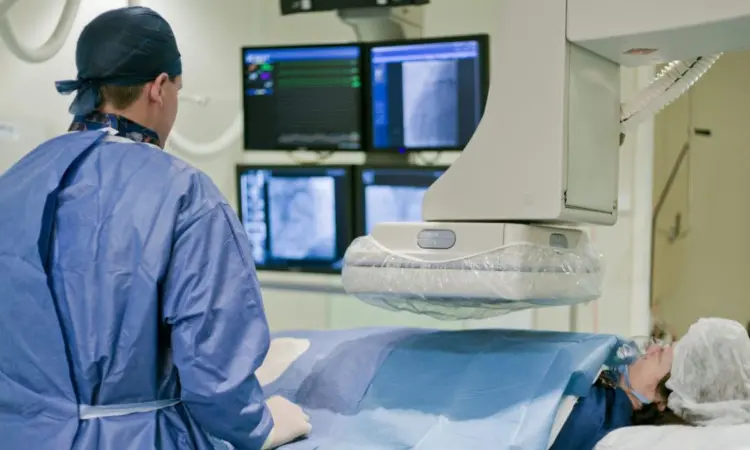- Home
- Medical news & Guidelines
- Anesthesiology
- Cardiology and CTVS
- Critical Care
- Dentistry
- Dermatology
- Diabetes and Endocrinology
- ENT
- Gastroenterology
- Medicine
- Nephrology
- Neurology
- Obstretics-Gynaecology
- Oncology
- Ophthalmology
- Orthopaedics
- Pediatrics-Neonatology
- Psychiatry
- Pulmonology
- Radiology
- Surgery
- Urology
- Laboratory Medicine
- Diet
- Nursing
- Paramedical
- Physiotherapy
- Health news
- Fact Check
- Bone Health Fact Check
- Brain Health Fact Check
- Cancer Related Fact Check
- Child Care Fact Check
- Dental and oral health fact check
- Diabetes and metabolic health fact check
- Diet and Nutrition Fact Check
- Eye and ENT Care Fact Check
- Fitness fact check
- Gut health fact check
- Heart health fact check
- Kidney health fact check
- Medical education fact check
- Men's health fact check
- Respiratory fact check
- Skin and hair care fact check
- Vaccine and Immunization fact check
- Women's health fact check
- AYUSH
- State News
- Andaman and Nicobar Islands
- Andhra Pradesh
- Arunachal Pradesh
- Assam
- Bihar
- Chandigarh
- Chattisgarh
- Dadra and Nagar Haveli
- Daman and Diu
- Delhi
- Goa
- Gujarat
- Haryana
- Himachal Pradesh
- Jammu & Kashmir
- Jharkhand
- Karnataka
- Kerala
- Ladakh
- Lakshadweep
- Madhya Pradesh
- Maharashtra
- Manipur
- Meghalaya
- Mizoram
- Nagaland
- Odisha
- Puducherry
- Punjab
- Rajasthan
- Sikkim
- Tamil Nadu
- Telangana
- Tripura
- Uttar Pradesh
- Uttrakhand
- West Bengal
- Medical Education
- Industry
Oesophagal fistula rare but dreadful complication of AF catheter ablation: POTTER-AF study

Germany: The POTTER-AF study reported results from a worldwide survey on the incidence, prognosis and management of oesophagal fistula formation following AF (atrial fibrillation) catheter ablation.
The study's findings, published in the European Heart Journal, showed that Esophageal fistula formation is a rare but deadly complication that occurs mainly with radiofrequency rather than cryo energy. Mortality without endoscopic or surgical intervention is exceptionally high.
The researchers reported 138 documented cases of oesophagal fistula in more than 550,000 ablations for AF performed in 35 countries at the European Heart Rhythm Association (EHRA) 2023 congress. The mortality of oesophagal fistula after catheter ablation for atrial fibrillation was 65.8%. The mortality following endoscopic (56.5%) or surgical treatment (51.9%) was significantly lower than conservative treatment (89.5%).
Considering the sparse data on the incidence, management and outcome of oesophageal fistula after catheter ablation for atrial fibrillation treatment, Roland Richard Tilz, University Hospital Schleswig-Holstein, Germany, and colleagues investigated the characteristics of oesophageal fistulae after atrial fibrillation catheter ablation in an international multicenter registry.
The authors reported 553,729 catheter ablation procedures (cryoballoon: 36.2%, radiofrequency: 62.9%, other modalities: 0.9%) at 214 centres in 35 countries. In 78 centres, 138 patients (0.025%, cryoballoon: 0.0015%, radiofrequency: 0.038%) were diagnosed with an oesophagal fistula. Periprocedural data were available for 85.5% of patients.
The study led to the following findings:
- Following catheter ablation, the median time to diagnosis and symptoms were 21 days and 18 days, respectively.
- The median time from symptom onset to oesophageal fistula diagnosis was three days.
- Fever was the most common initial symptom (59.3%). The diagnosis was established by chest CT (computed tomography) in 80.2% of patients.
- Oesophageal surgery was conducted in 47.4%, conservative treatment in 32.8%, and direct endoscopic treatment in 19.8% of patients.
- The overall mortality was 65.8%. Mortality following endoscopic (56.5%) or surgical (51.9%) treatment was remarkably lower as compared to conservative management (89.5%) (odds ratio 7.463).
"Esophagal fistula formation is a rare but deadly complication after catheter ablation of atrial fibrillation, and the risk is mostly restricted to ablations done with radiofrequency energy versus cryoenergy," the researchers conclude.
Reference:
Tilz, R. R., Schmidt, V., Pürerfellner, H., Maury, P., Chun, K. J., Martinek, M., Sohns, C., Schmidt, B., Mandel, F., Gandjbakhch, E., Laredo, M., Gunawardene, M. A., Willems, S., Beiert, T., Borlich, M., Iden, L., Füting, A., Spittler, R., Gaspar, T., . . . Heeger, C. A worldwide survey on incidence, management and prognosis of oesophageal fistula formation following atrial fibrillation catheter ablation: The POTTER-AF study. European Heart Journal. https://doi.org/10.1093/eurheartj/ehad250
Dr Kamal Kant Kohli-MBBS, DTCD- a chest specialist with more than 30 years of practice and a flair for writing clinical articles, Dr Kamal Kant Kohli joined Medical Dialogues as a Chief Editor of Medical News. Besides writing articles, as an editor, he proofreads and verifies all the medical content published on Medical Dialogues including those coming from journals, studies,medical conferences,guidelines etc. Email: drkohli@medicaldialogues.in. Contact no. 011-43720751


